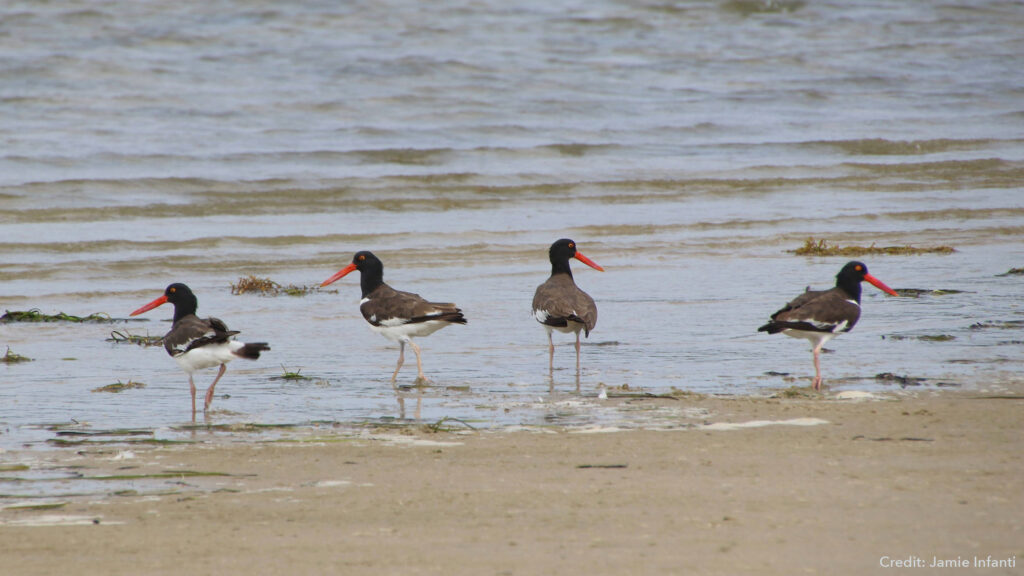
AMOY Research & Monitoring in Massachusetts
Research
Population Dynamics of the American Oystercatcher in Massachusetts
American Oystercatchers (Haematopus palliatus) expanded their range north along the Atlantic Coast, reaching Massachusetts in 1969. Concurrent to northward range expansion, oystercatchers have declined in the core part of their range, and have been designated a “Species of High Concern” by the U.S. Shorebird Plan. We are examining the demographics of a migratory population of American Oystercatchers in Massachusetts to explore factors influencing local populations throughout the state. We are estimating fecundity, stage-specific survival, and movement using a variety of field and statistical techniques. We are collecting nesting data for oystercatchers on Nantucket Island are investigating factors influencing reproductive success. To date, all measures of reproduction were higher than those from most other Atlantic Coast populations. We hypothesize that island populations experience higher reproductive success due to the absence of mammalian predators, and these populations may be sustaining mainland populations. Furthermore, we are examining egg and chick survival to identify nesting stages to focus conservation efforts. We are color banding breeding adults and near-fledging chicks throughout the state and using mark-recapture techniques to estimate survival, breeding-site fidelity, and natal philopatry for American Oystercatchers. From the first four years of the study, we report a high rate of adult survival (0.92) and a strong, but variable, degree of breeding-site fidelity (between 0.97 and 0.99). We are starting to investigate juvenile and subadult annual survival. Eventually, these key demographic measures will parameterize a population model to investigate local and state-wide population trends. Our analyses will provide a foundation for continued examination of shorebird population demographics, a model for demographic analyses of a species of conservation concern, and a preliminary work illuminating the advantages of dispersal and the relationship between breeding-site fidelity and reproductive success. For more information, contact Sean Murphy.
Past Research
Productivity and Color-Banding of American Oystercatchers on Monomoy National Wildlife Refuge
The summer of 2003 was the first season of intensive monitoring of American Oystercatchers in Massachusetts since the early 1980s. We monitored nesting success for all breeding oystercatchers on Monomoy National Wildlife Refuge in 2003, 2004, and 2005. Objectives for this work included documenting the productivity and sources of nest and chick loss for a northeast breeding population of American oystercatchers.
The project was a cooperative effort between Monomoy National Wildlife Refuge and the Manomet Center for Conservation Science, and was initially funded through the USGS Quick Response Program and the QLF Sounds Conservancy Program.
A color-banding and radio telemetry effort was initiated in 2003 with sixteen birds color-banded and twelve radio tagged. to date, 46 oystercatchers have been banded on this project. Objectives for the banding study included documenting dispersal, migration, survival, and recruitment for a population of oystercatchers in the Northeast US.
Banding
Trapping Techniques and Color Banding of American Oystercatchers in Massachusetts
We color band American Oystercatchers throughout coastal Massachusetts. During the nesting season, we identify breeding pairs by searching potential nesting areas for adult oystercatchers. Once a pair of adults is located, breeding pairs were not trapped during the egg laying stage or the egg hatching stage. We trap adults using two different techniques, leg-hold noose mats (McGowan and Simons 2005) and small whoosh nets (developed by Peter Doherty). Both of these techniques use decoys and playbacks to lure territorial birds into the trap.
Additionally, we capture nestling oystercatchers by hand to ensure the safety of the young birds. We capture all young and color band them once they reach a minimum age of 21 days. Over the course of regular nest checks, cooperating shorebird monitors confirm the successful fledging of banded young. Breeding oystercatchers typically remain near their breeding territory until late July, thus facilitating the observation of banded adults associated with a specific banded fledgling.
For more information, contact Sean Murphy.
Massachusetts Banding Schemes
There may be occasional variation in timing and leg placement of banding schemes.
2013 – present: Duplicate yellow bands with black triangle-code configuration (three black engraved horizontally-oriented letters/numbers with one character above two characters) on upper legs; single metal band on either lower leg.
2004-2013: Duplicate yellow bands with black horizontal code (two black engraved horizontally-oriented letters/numbers) on upper legs.
2003: Colors used: Red, Yellow, Light Blue, Black. Adult Birds: Upper Left: Large Yellow band engraved with a Black letter (A or B), Lower Left: One color band, Upper Right: Black band, Lower Right: One color band over USFWS band. Juvenile Birds: Upper Left: Black band, Lower Left: One color band over USFWS band, Upper Right: Large Yellow band engraved with a Black letter (A or B), Lower Right: One color band. Note: In 2003 some birds were outfitted with black radio transmitters attached to the large yellow color bands. These radios should fall off by summer 2004.
View Historical Banding Information (PDF).
Massachusetts Contacts
- Eileen McGourty – Fish and Wildlife Biologist, Monomoy National Wildlife Refuge
- Stephen Brown – Manomet Center for Conservation Sciences
- Shiloh Schulte – Manomet Center for Conservation Sciences
- Richard Veit – Biology Department, College of Staten Island
- Brad Winn – Manomet Center for Conservation Sciences
- Karen Beattie – Nantucket Conservation Foundation, Inc.
Massachusetts Participants
- BiodiversityWorks
- College of Staten Island
- Manomet Center for Conservation Science
- Monomoy National Wildlife Refuge
- Nantucket Conservation Foundation
